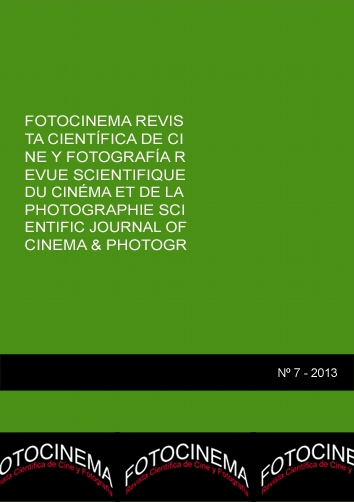El cuerpo, la piel y la pantalla: los territorios habitados por Pedro Almodóvar
DOI:
https://doi.org/10.24310/Fotocinema.2013.v0i7.5931Abstract
En este artículo se estudian las implicaciones que tiene en La piel que habito la cuestión del cuerpo y de su territorio. Las interrogaciones sobre la identidad del sujeto, presentes en toda la filmografía de Pedro Almodóvar, alcanzan aquí su culminación concerniendo no solamente a la identidad del individuo sino también a la de las obras.El juego de correspondencias instaurado por Pedro Almodóvar entre la cirugía plástica y la costura, entre la piel y el tejido, se prolonga en la relación plástica y visual que se establece entre la pantalla y el cuadro pictórico para desembocar en el trabajo del cine como arte del ensamblaje y la sutura. Para explorar las múltiples pistas que ofrece la película, la autora se vale de referencias a la mitología, al concepto de “Yo-Piel” creado por Didier Anzieu y a la dimensión háptica de la imagen desarrollada por Gilles Deleuze.
In this article are studied the implications of the body’s question and its territory in The Skin I Live In. The interrogations about the identity of the subject, which are present in the whole filmography of Pedro Almodovar, are reaching here their culmination point concerning not only the identity of the individual, but also the identity of the movies.The concept of the cinematographic art as an assembling and seaming art is echoed in the plastic and visual relation that is established between screen and painting, as Pedro Almodovar institutes a matching game between plastic surgery and sewing, between skin and tissue.
To explore the multiple clues that offers the movie, the author uses references to mythology, to the concept of “I-Skin” developed by Didier Anzieu and to the haptic of pictures developed by Gilles Deleuze.
Palabras clave: Almodóvar ; La piel que habito ; Moi-Peau ; pintura ; mitología ; transtextualidad.
Keywords: Almodovar; The Skin I Live In; Moi-Peau; Painting; Mitology; Transtextuality.
Downloads
Metrics
Downloads
Published
How to Cite
Issue
Section
License
All contents published in Fotocinema Revista científica de cine y fotografía are protected under the Creative Commons Attribution-NonCommercial-ShareAlike 4.0 International (CC BY-NC-SA 4.0) license. All about this license is available in the following link: <http://creativecommons.org/licenses/by-nc-sa/4.0>
Users can copy, use, redistribute, share and exhibit publicly as long as:
- The original source and authorship of the material are cited (Journal, Publisher and URL of the work).
- It is not used for comercial purposes.
- The existence of the license and its especifications are mentioned.
There are two sets of authors’ rights: moral and property rights. Moral rights are perpetual prerogatives, unrenounceable, not-transferable, unalienable, imprescriptible and inembargable. According to authors’ rights legislation, Fotocinema. Revista científica de cine y fotografía recognizes and respects authors moral rights, as well as the ownership of property rights, which will be transferred to University of Malaga in open access. The property rights are referred to the benefits that are gained by the use or the dissemination of works. Fotocinema. Revista científica de cine y fotografía is published in an open access form and it is exclusively licenced by any means for doing or authorising distribution, dissemination, reproduction, , adaptation, translation or arrangement of works.
Authors are responsable for obtaining the necessary permission to use copyrighted images.













13.png)




